See boats from other years | See this year’s boats
-
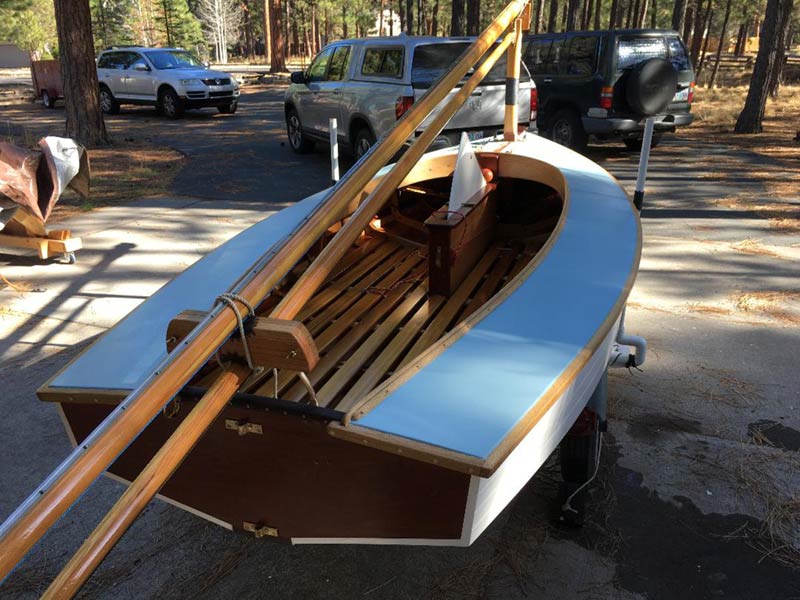 1932 Los Angeles Olympics MonotypeYear Built: OtherLOA: 19'6"Owner: Peter & Eric HazellDesigner: Tom BroadwayDesign: SnowbirdType: Sloop
1932 Los Angeles Olympics MonotypeYear Built: OtherLOA: 19'6"Owner: Peter & Eric HazellDesigner: Tom BroadwayDesign: SnowbirdType: SloopThis boat was self-built, by brothers Peter and Eric Hazell in Sisters, OR in 2016-2017. The 12′ catboat is a replica of a 1932 Los Angeles Olympics, single-crewed racer (Snowbird), standardized in design by Naval Architect, Edson B. Schock.Our boat’s traditional construction is Western Red Cedar planked on sawn and steam-bent White Oak frames with mahogany stem, keel and transom. The boat is a canvas-decked, hard-chined, centerboard, racing catboat, entirely bronze and copper fastened. The hardware is silicon-bronze and brass, with many components created by hand. This design was raced in the 1950s-1960s in the Flight of the Snowbirds in Newport Beach, CA, often with nearly 200 entries. To the best of our knowledge, this is the first Snowbird traditionally built since the early 1950s.
-
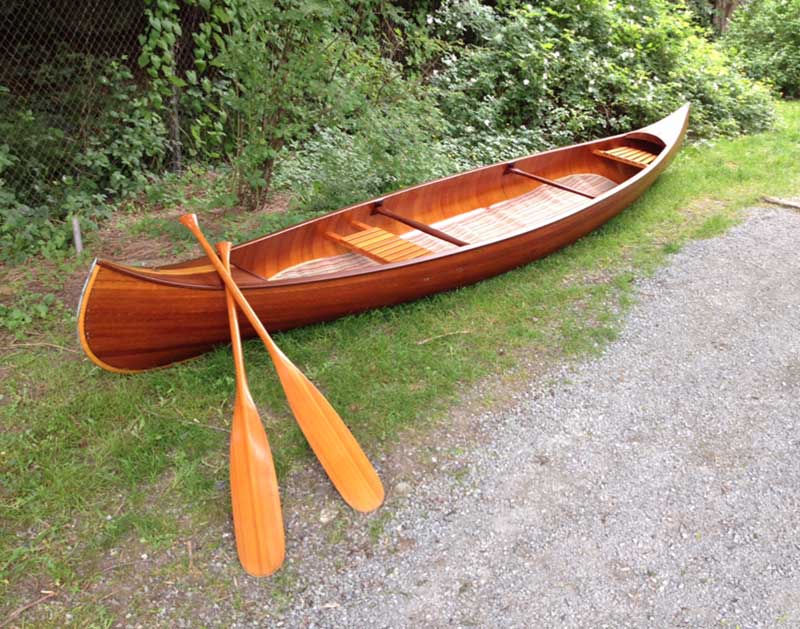 Willets Brothers canoeYear Built: 1956LOA: 17'Owner: Steve DavisDesigner: WilletsDesign: WilletsType: Canoe
Willets Brothers canoeYear Built: 1956LOA: 17'Owner: Steve DavisDesigner: WilletsDesign: WilletsType: Canoe1956 Willets Brothers canoe purchased brand new by my father. All original, never restored, almost every original accessory with some never used still in Willets hand made bags.. Stunning boat that gathers crowds.
-
 Admiral's BargeYear Built: UnknownLOA: 16'Beam: 5'Owner: Michael MoenigDesigner: Bill GardenDesign: Port Madison PramType: Sloop
Admiral's BargeYear Built: UnknownLOA: 16'Beam: 5'Owner: Michael MoenigDesigner: Bill GardenDesign: Port Madison PramType: SloopThis boat has been in the family for decades. She sailed the waters of Lake Washington for decades, later ownership passing on and spending decades in dry storage. In 2014 she was hauled out of storage and given a new lease on life with a complete hull repaint, fiberglass restoration, and replacement hardware. Some strategic upgrades such as a British Seagull outboard and modern rigging touches enable comfortable saltwater sailing in Sequim and Discovery Bay.
She sails beautifully in local salt waters, high freeboard and shallow draft and stout construction gives confidence and comfort in light swells. She seems to sail best with 2-3 people aboard and is a pleasant cruiser in most any conditions. Easily rigged, launched, and retrieved on unimproved ramps.
She is towed well by a 1971 Holsclaw tilt-trailer, making easy work of launching into primitive Puget Sound launches. Debuted at Port Townsend Wooden Boat Festival in 2016.
-
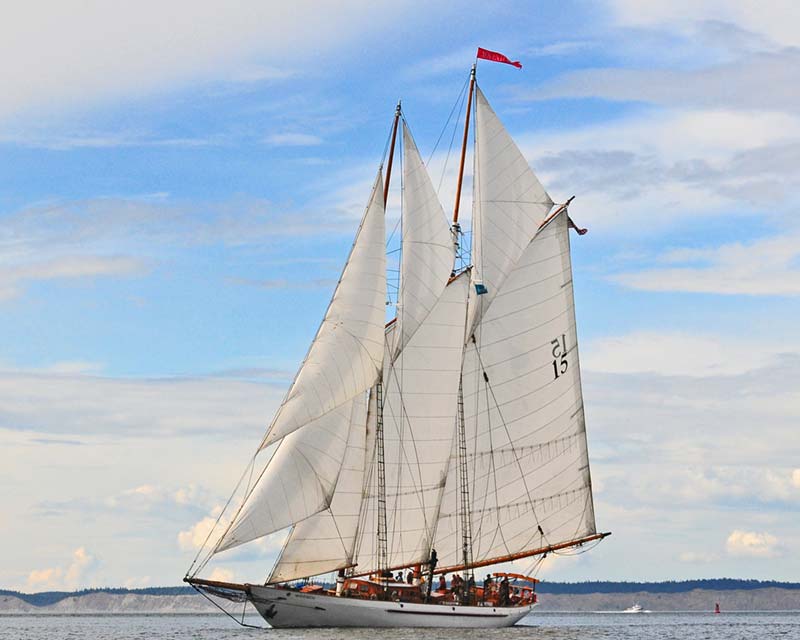 AdventuressHome Port: Port Townsend, WAYear Built: 1913LOA: 133'Beam: 21'Owner: Sound ExperienceDesigner: B.B CrowninshieldDesign: One-offType: Schooner
AdventuressHome Port: Port Townsend, WAYear Built: 1913LOA: 133'Beam: 21'Owner: Sound ExperienceDesigner: B.B CrowninshieldDesign: One-offType: SchoonerSound Experience sails the historic schooner Adventuress to educate, inspire, and empower an inclusive community that works to improve our marine environment and celebrates our maritime heritage. Since her launch in E. Boothbay, Maine, in 1913, the B.B. Crowninshield-designed schooner has traveled the Strait of Magellan and the Bering Sea on an arctic expedition for naturalist Roy Chapman Andrews; served as a Bar Pilot vessel off of San Francisco; patrolled the west coast during World War II; and trained young sailors in seamanship skills in Seattle with Youth Adventure. Adventuress has sailed on the waters of Puget Sound for almost three decades under the stewardship of nonprofit Sound Experience, offering hands-on environmental education and leadership development to thousands of young people annually and partnering with youth-serving organizations to reach at-risk kids. Sound Experience offers programs for all ages and backgrounds and takes pride in providing many levels of training opportunities for volunteer and paid crew. Adventuress is a National Historic Landmark officially recognized as “Puget Sound’s Environmental Tall Ship.”
-
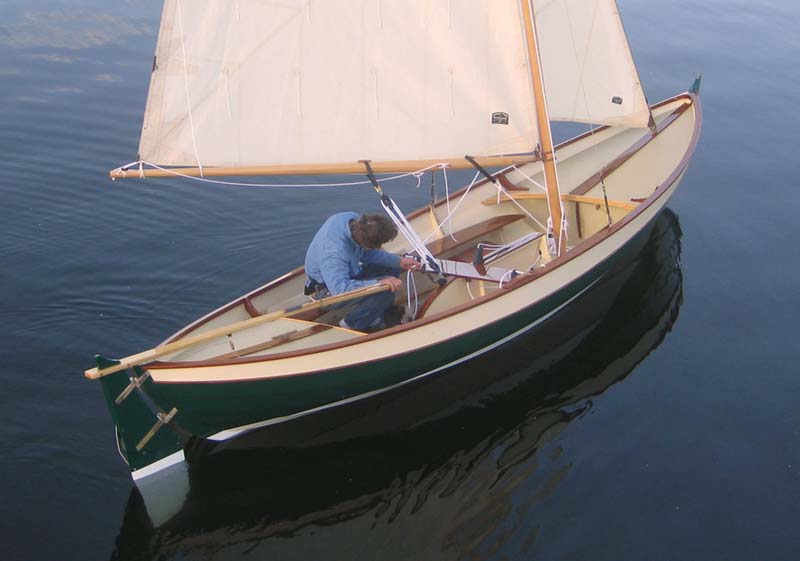 Arctic TernFor SaleYear Built: 2014LOA: 19' 4"Owner: David & Marian BergeyDesigner: Iain OughtredDesign: Arctic Tern - StretchedType: Sloop
Arctic TernFor SaleYear Built: 2014LOA: 19' 4"Owner: David & Marian BergeyDesigner: Iain OughtredDesign: Arctic Tern - StretchedType: SloopThis boat is a 19’4″ stretched version of Iain Oughtred’s Arctic Tern. She features an enlarged gunter sloop rig with decks and bulkheads fore and aft. Originally designed at 18’2″” in length, the owner preferred the longer length of the Caledonia Yawl, and the narrower beam of the Arctic Tern. Thus this is a hybrid of the two.
Nathaniel Wilson of East Boothbay, Maine made the lovely mitre-cut sails. This boat is primarily used for day sailing on Lake Washington so auxiliary propulsion is handled by oars. With the generous sail plan they are rarely required. Built in 2014 by Tom Regan of Grapeview Point Boat Works.”
-
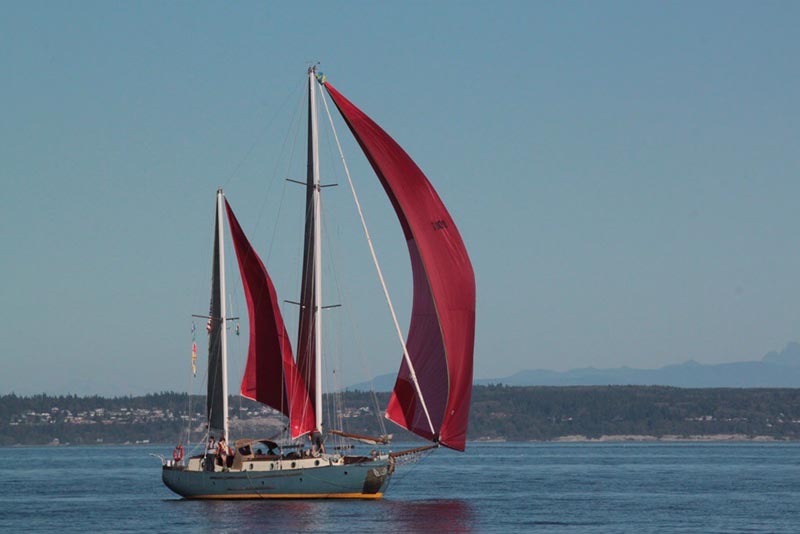 Ariel of VictoriaHome Port: Anacortes, WAYear Built: 1980LOA: 58'Beam: 13'6"Owner: Christine Scoggins GranquistDesigner: Fred PetersonDesign: One-offType: Ketch
Ariel of VictoriaHome Port: Anacortes, WAYear Built: 1980LOA: 58'Beam: 13'6"Owner: Christine Scoggins GranquistDesigner: Fred PetersonDesign: One-offType: KetchAriel of Victoria’s keel was laid in Fred Peterson’s boatyard on Vancouver Island near Nanaimo in 1972. Carvel planked in Alaskan yellow cedar over oak frames with a western red cedar deck, she was launched in 1980 after “seven years of madness” by Ronald Hunt and Peterson. Doug and Jane Bond bought her in Victoria and raised two sons aboard, sailing her in the Salish Sea and participating in the local racing community. In 2009, Jane sold Ariel to Christy Granquist who, with Daniel Joram, brought the boat to Seattle and began a hull & systems restoration/renovation project (planking, frames, transom and aft cabin, electrical, water, sewage). In 2012, another renovation push involved a new galley, engine rebuild, fuel & exhaust systems. And in 2015, she was hauled out for 18 months to rebuild her decks and main cabin, re-cork, fair, install new steering & nav systems.
In between all the projects Ariel of Victoria sails extensively, covering 5000 miles in the Salish Sea between 2010 and 2015, and racing in several local events. We are looking forward to taking her further in the coming seasons.
-
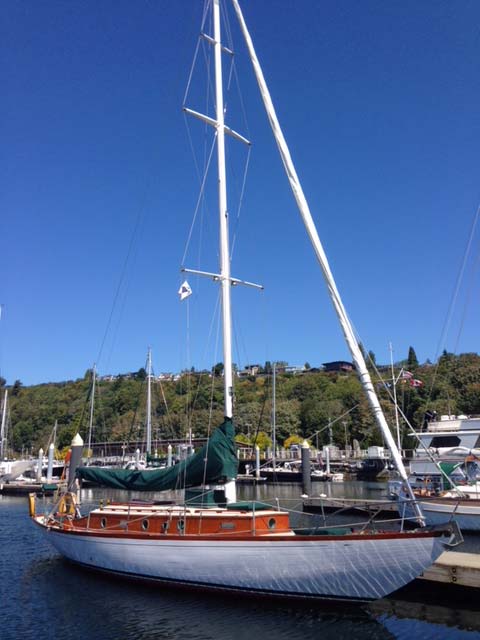 ArroyoHome Port: Seattle, WAYear Built: 1938LOA: 42'Beam: 10' 2"Owner: Roger & Nancy NewellDesigner: Ben SeabornDesign: SeabornType: Sloop
ArroyoHome Port: Seattle, WAYear Built: 1938LOA: 42'Beam: 10' 2"Owner: Roger & Nancy NewellDesigner: Ben SeabornDesign: SeabornType: SloopBuilt in 1938 by Blanchard Boat Company in Seattle for Markus Mayer Jr as “We’re Here”. Launched with sistership Tola. Past owners include Dr. Carl Jensen, AC Woodley, David Skinner and Dr. Robert Smith. Over the years the name was changed from We’re Here to Oscar IV, Avolonte, Kate, and currently Arroyo. The yacht was extensively raced in NW waters winning the 1949 Swiftsure Lightship Race and numerous Seattle yacht Club races. A half hull of the yacht currently hangs in the dining foyer of the Seattle Yacht Club.
From 1995-2000 the yacht underwent extensive restoration in Pt. Townsend under the guidance of Phil Rome and many other marine craftspeople from Pt. Townsend. Reconstruction included replacing 80 ribs, new deck, and deck beams, a new cockpit, new electrical, rebuilt engine, new electronics, prop, shaft, exhaust, galley, and complete hull fastening. New sails were added in 2001 and a new diesel engine in 2014. Arroyo has participated in numerous wooden boat festivals in Seattle and Pt. Townsend. The yacht is currently moored on Lake Union, only minutes from where the yacht was originally launched.
Construction includes: 1 1/8″ cedar planks on 2’x2′ oak frames, 3/4″ Okume plywood decking on mahogany beams, spruce mast and boom, System 3 fiberglass deck coating with silica sand, teak and mahogany brite work, and a Yanmar 40 hp diesel engine.
-
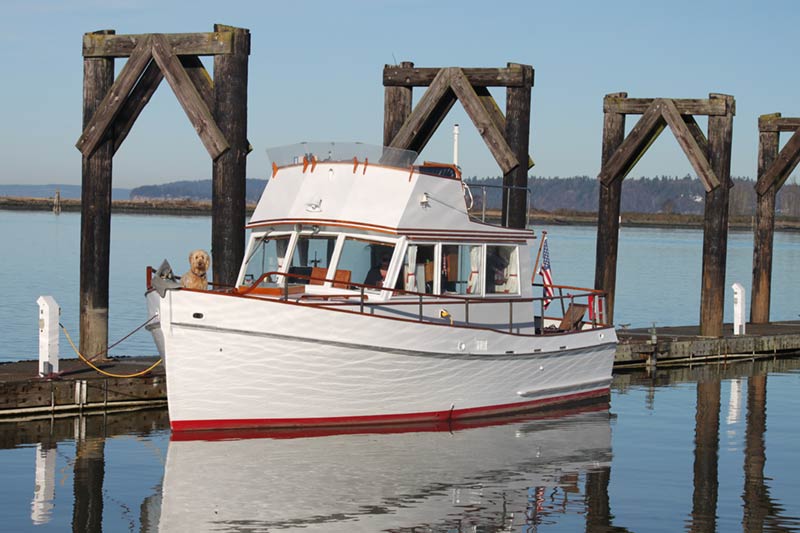 Bella la VitaFor SaleYear Built: 1969LOA: 34'Beam: 11'6"Owner: Linn JenningsDesigner: Grand BanksDesign: Grand Banks 32 SedanType: Power
Bella la VitaFor SaleYear Built: 1969LOA: 34'Beam: 11'6"Owner: Linn JenningsDesigner: Grand BanksDesign: Grand Banks 32 SedanType: PowerA Grand Banks 32 sedan, built in 1969, Bella la Vita has proven to be nearly perfect for the cruising couple. Dependable, economical, if not a little slow, she has carried her current owners throughout Puget Sound, the San Juans, and into Canada.
-
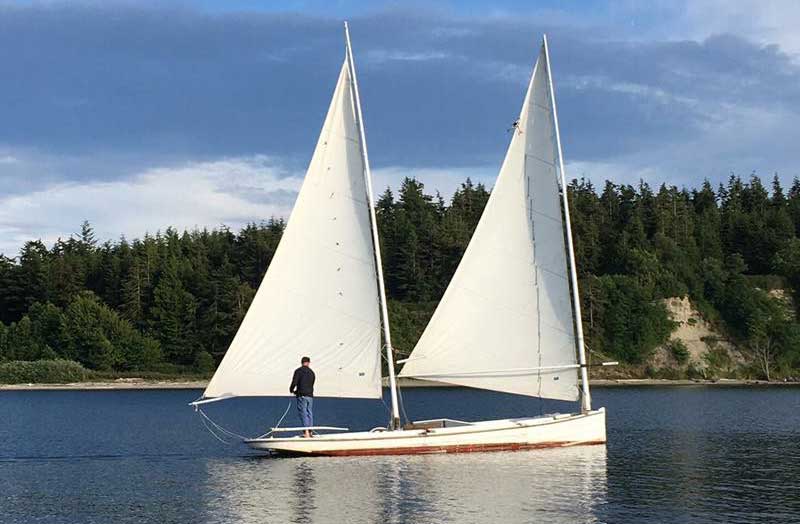 Betsy DYear Built: 1977LOA: 35' 6"Beam: 6' 6"Owner: Jake BeattieDesigner: TraditionalDesign: New Haven SharpieType: Ketch
Betsy DYear Built: 1977LOA: 35' 6"Beam: 6' 6"Owner: Jake BeattieDesigner: TraditionalDesign: New Haven SharpieType: KetchBuilt in Anacortes in 1977 (same year as the first Port Townsend Wooden Boat Festival) by a 20 year old aspiring boat builder named Bo Garrison who took the lines from Chappelles American Small Craft. The boat’s design is an evolution from dugout canoes, and came into service for watermen in Long Island Sound for ease of construction, speed, ease of handling, and shoal draft- which made it ideal for tonging for oysters.
The rig is consists of two solid, unstayed spars, with sprit-booms that are tensioned with “snotter lines” against lashings on the mast. Oddly, the sails reef vertically; the snotter lines are eased and the luff of the sail is gathered at the mast. Honestly, it’s a pretty bad system since you have to strike the sail, tie every reef point as you re-raise it, and what you are left with is a bunched up sail as the leading edge of your sail. Eventually we’re going to get around to changing that.
A modern adaptation of that hull form, the Betsy D was originally named Transit and had a full cabin, and the builder cruised it extensively in the Salish Sea, making it as far north as Desolation Sound. In 1983 it was donated to Seattle’s Center for Wooden Boats where it was a long serving member of the fleet, primarily as the public sail vessel; every Sunday it would take people sailing in Lake Union free of charge. The current owners, Jake Beattie and Jean Scarboro, fell in love with the boat while employees there, and when they heard it was being surplussed jumped at the chance to be its caretakers. They traded a Port Madison pram for the boat and set in on a year long restoration. They both now live in Port Townsend and camp cruise it with their daughter in the summers.
-
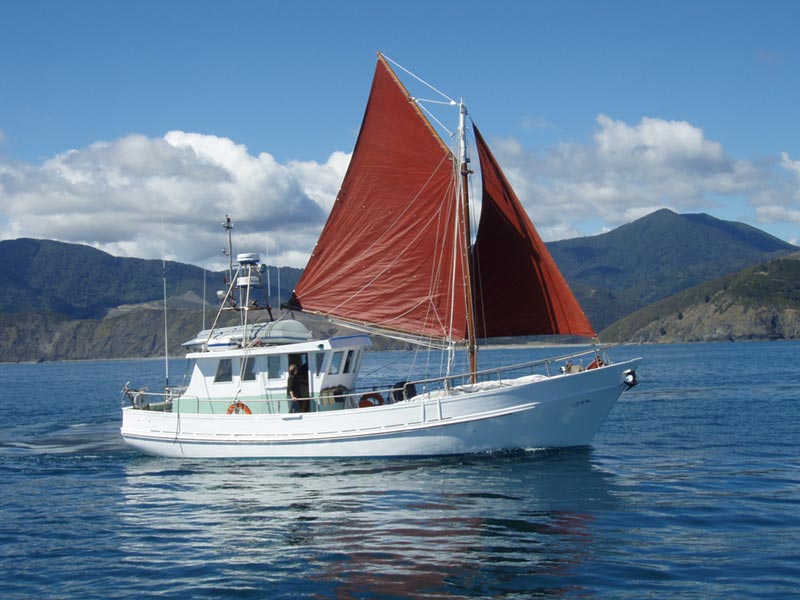 Betty McFor SaleYear Built: 1963LOA: 45'Beam: 15'Owner: Rodger GraysonDesigner: Ken LaccoDesign: Southern Rock Lobster (Cray) boatType: Commercial fishing with sail assist
Betty McFor SaleYear Built: 1963LOA: 45'Beam: 15'Owner: Rodger GraysonDesigner: Ken LaccoDesign: Southern Rock Lobster (Cray) boatType: Commercial fishing with sail assistBetty Mc is a 45′ “crayfish” boat, typical of many fishing craft from south eastern Australia built throughout the 1900s. Early boats were all sail and as engines improved, sail rigs shrunk. Betty Mc is one of the last era of boats to retain a sail rig. She was built in 1963 by Ken Lacco for his son Snow, who began fishing in 1964 in Victorian and Tasmanian waters. She was fishing commercially until 2001 when we purchased her. We refitted her for “spartan” long-distance cruising in 2006 with the removal of deck machinery, a new engine, transmission and genset, and a larger wheelhouse. All holds were retained, including the 6m3 “wet-well”. In 2007 she left Australia, visiting New Zealand, many central pacific islands, Micronesia, Japan and the Aleutian Islands arriving in the Pacific Northwest in 2011. Following several seasons between Vancouver and Kodiak she travelled south down the west coast to Mexico and through Central America as far as Costa Rica. She is carvel planked in Celery Top Pine on laminated frames of Yellow Stringybark with a keel and keelson of ironbark, all common Australian timbers for commercial craft.
-
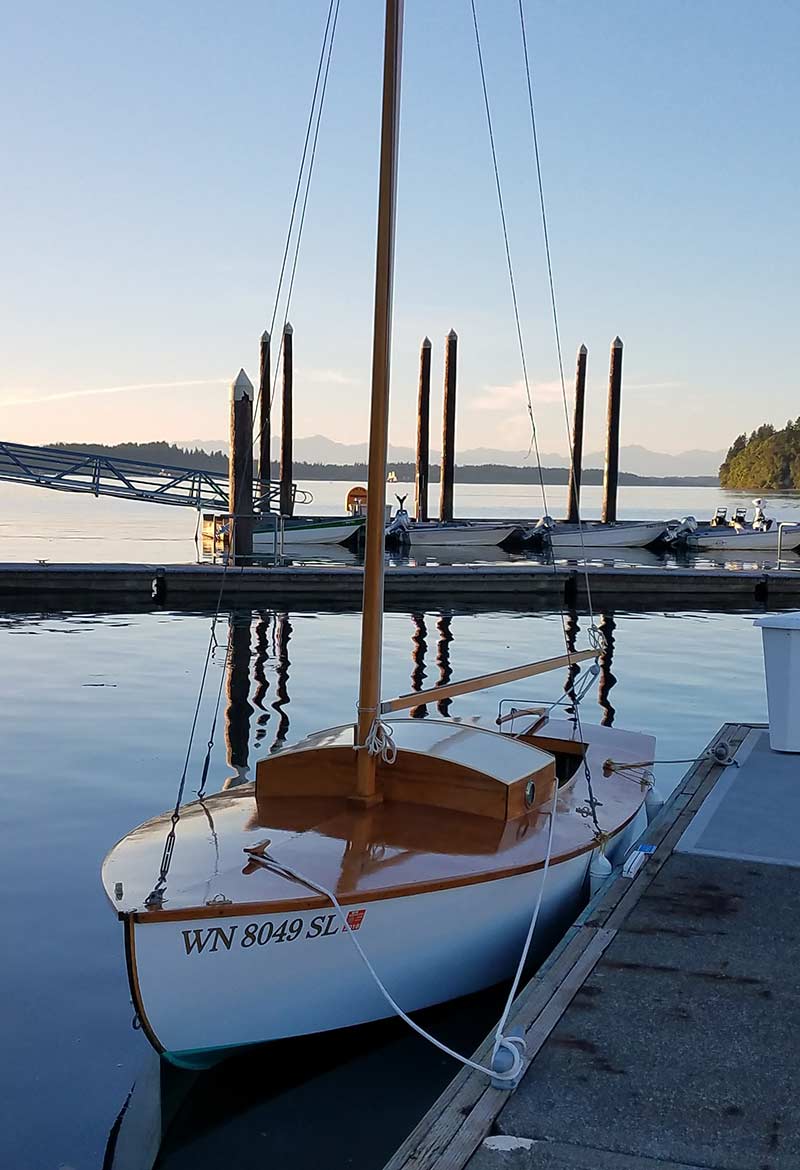 BibiYear Built: 1964LOA: 16' 6"Beam: 6' 2"Owner: Kristopher Hicks-GreenDesigner: Ludvik "Louie" Piotr ZbigniewiczDesign: One-offType: Sloop
BibiYear Built: 1964LOA: 16' 6"Beam: 6' 2"Owner: Kristopher Hicks-GreenDesigner: Ludvik "Louie" Piotr ZbigniewiczDesign: One-offType: SloopBibi is a hard-chined, plywood centerboard sloop built in 1964 by hobbyist Ludvik Zbigniewicz, apparently to his own design. She has a long, fine entry, considerable rocker, and a tiny, distinctively squared-off cuddy with a small porthole on either side. BIBI is bronze fastened and heavily framed for her size—a reflection of both the conservative approach taken by builders experimenting with plywood in its relatively early days, and also of the fierce prairie winds and steep chop on Lake Winnipeg, for which the builder designed her.
Her prior owner, Jack Mathias of Nanaimo BC, owned her from 1997 until 2017, and relayed this history. “She was built…for sailing solo on Lake Winnipeg … If you don’t know that lake, it’s roughly 400 km long, north to south, 100 km wide, and averages only 12 m deep. With that length of wind fetch, flat surrounding countryside and shallow depth, the lake can get extremely rough. That’s why the vessel is built so strongly, comes with a canvas storm jib and a drogue, has extra fore and aft flotation, and has the roller boom for reefing the mainsail. I suspect the small thermometer and barometer mounted in the forward bulkhead of the cabin is to watch for squalls and thunderstorms, for which the prairies are famous.”
The builder’s daughter confirmed that Mr. Zbigniewicz built BIBI. “As a matter of fact”, she wrote, “he built several and this one was the largest, built when the new baby was born, to accommodate his growing family. I’m that baby.”
Zbigniewicz was born in 1918 in Warsaw, Poland. He enrolled in the Sea Cadets and sailed tall ships in the Baltic. He enlisted in 1939 and served in the Polish army before being captured by the Germans and imprisoned for the duration of World War II. After being liberated, he rejoined Polish troops in Italy and eventually emigrated to Manitoba, where he worked variously as a farm hand, lumberjack, for a gas company, and as a business owner. In addition to woodworking, Zbigniewicz also enjoyed working in metals, and he cast or machined all of the metal fittings on BIBI. He passed away in 1997.
With only three owners from new, BIBI remains remarkably original and is a proper little yacht. -
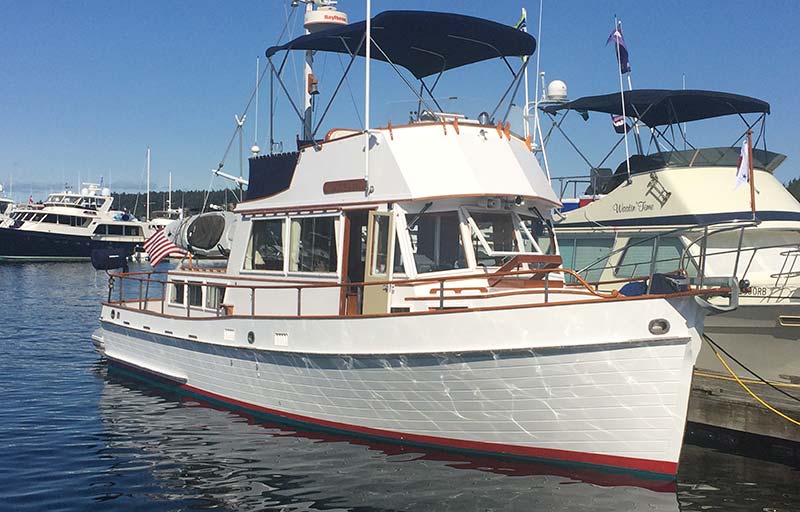 Black OpalYear Built: 1973LOA: 41'Beam: 12'6"Owner: Jerry NormanDesigner: UnknownDesign: Classic 36Type: Power
Black OpalYear Built: 1973LOA: 41'Beam: 12'6"Owner: Jerry NormanDesigner: UnknownDesign: Classic 36Type: PowerBlack Opal is a Classic Grand Banks 36 Trawler. This boat was purchased and totally redone by it’s previous owners Jim and Barbara Thiele. They enjoyed her for many years and kept her under cover at Pleasant Harbor. She has cruised to Alaska. Currently she is kept under cover at La Conner Marina and we enjoy cruising her in the San Juan Island.
-
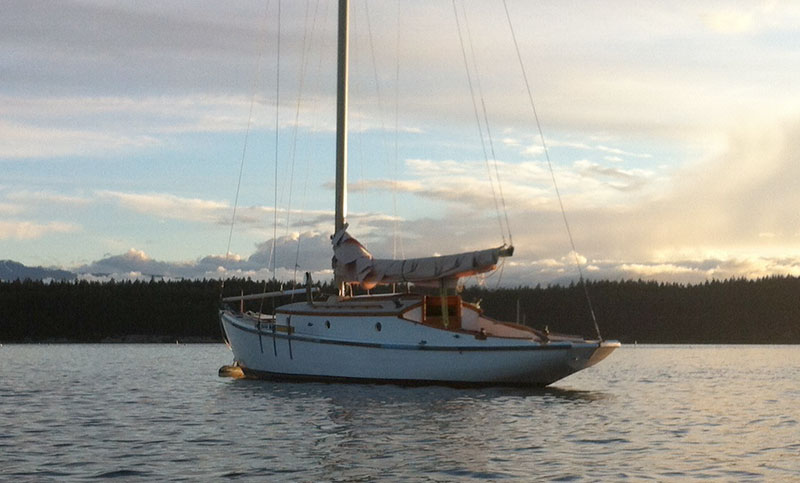 BlossomYear Built: 1938LOA: 28'6"Beam: 7'10"Owner: Erica GeorgaklisDesigner: Ed. Monk SrDesign: UnknownType: Sloop
BlossomYear Built: 1938LOA: 28'6"Beam: 7'10"Owner: Erica GeorgaklisDesigner: Ed. Monk SrDesign: UnknownType: SloopBlossom was built in 1938 in Tacoma, WA by the Anderson yard. Several similar sloops of Ed. Monk’s designs were being constructed in the late 30’s and early 40’s including S/V Sea Witch. She is heavily constructed of yellow cedar planks on white oak frames with a Douglas fir backbone and iron ballast.
Much of her history before 2000 is unknown to the current owner, but she was very well kept for a long time – much of her structure appears original. In the mid 2010’s she was in Sam Devlin’s yard and received a new ply deck, was refastened below the waterline, had most of her butt blocks below the waterline scarfed out, an aluminum deck stepped rig, and 2003 Yanmar 2GM20. In 2016-17 her mast step and surrounding floors were replaced, as were many of the surrounding frames.
Blossom has explored extensively in the San Juan’s but not much further. With a long way to go in her restoration, Blossom’s owner hopes to soon explore the Gulf Islands, and further north. Come see Blossom and help us celebrate her 80th birthday!
-
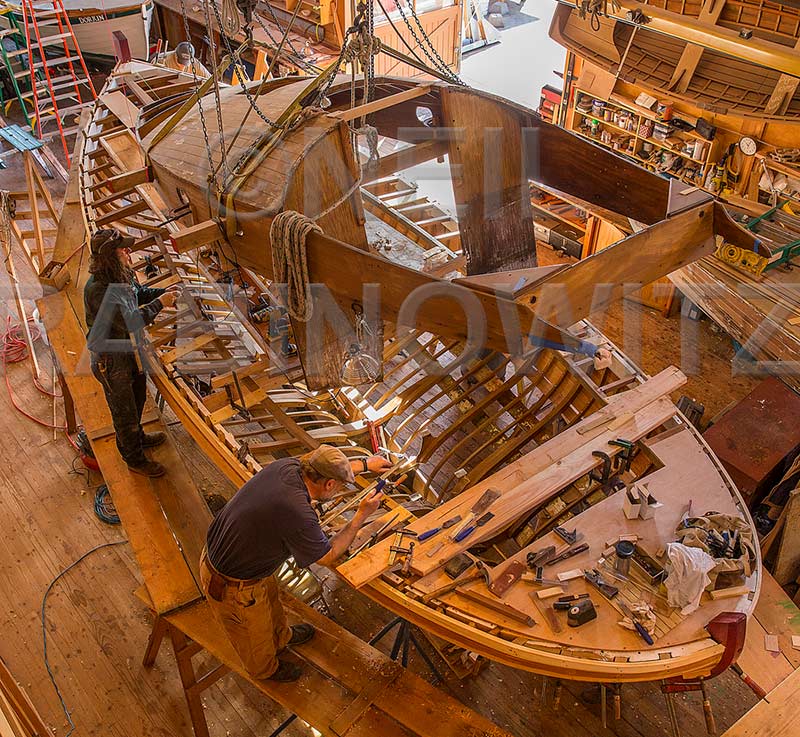 BoutYear Built: 1939LOA: 28'Beam: 8'7"Owner: Oliver and Janice PedersenDesigner: M.S.J. HansenDesign: 38 Square Meter SpidsgatterType: Sloop
BoutYear Built: 1939LOA: 28'Beam: 8'7"Owner: Oliver and Janice PedersenDesigner: M.S.J. HansenDesign: 38 Square Meter SpidsgatterType: SloopThis 38 square meter sloop designed by Marius Sofus Joannes Hansen in November, 1935, was built by Thomsen Boatyard in Kalundborg, Denmark and launched in 1939.
Bout has undergone a complete, loving, restoration beginning in September 2017 by Robert D’Arcy and Douglas Jones, and their professional crew, Jason, Riley, Jen, and Zolly. All work was done inside the Port Townsend Maritime Building. Her construction is plank on frame using white oak framing, larch planks, and teak decks over angelique framing. The center line is purple heart.Her cabin is original with a new interior. Doug Jones reshaped the mast, and Port Townsend Foundry created all the bronze works. Sails were made by Carol Hasse, and rigging by Port Townsend Rigging. Brian Toss contributed as well. Walt Tisdale handled the new engine installation. Bout was able to hold onto her lead keel during WWII when Nazi Germany occupied Denmark. In 1966, she was solo sailed from San Diego to Hawaii and back by then owner Robert Sisler. Bout was purchased by Ollie and Janice Pedersen in 2006. Photo by Neil Rabinowitz
-
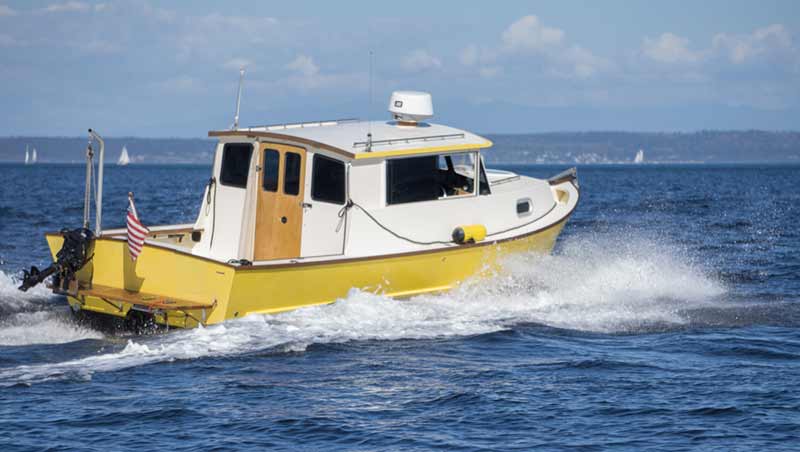 Bright StarHome Port: Lake Oswego, ORYear Built: 2004–2006LOA: 27'Beam: 8'Owner: Ray BrownDesigner: Renn TolmanDesign: Tolman Alaskan Skiff Jumbo 24Type: Power
Bright StarHome Port: Lake Oswego, ORYear Built: 2004–2006LOA: 27'Beam: 8'Owner: Ray BrownDesigner: Renn TolmanDesign: Tolman Alaskan Skiff Jumbo 24Type: PowerBright Star is a Tolman Jumbo 24, from a design by Renn Tolman of Homer, Alaska. As are all the Tolman boats, she is a plywood stitch-and-glue wooden boat.
The Tolman Alaskan Skiffs began as 18′ open boats, built for fishing in Alaskan waters. The basic design has evolved. Most now are cabin boats 22′-24′ long, with a few built at 26′, and built by the people who plan to use them.
Ray built her on our backporch. It took 2.5 years, from delivery of plywood to launching. We customized ours as a cabin cruiser, for cruising and fishing.
The boat is powered by a Cummins diesel MerCruiser 1.7L, 120hp, inboard/outboard. Cruising speed is 18 mph and cruising weight is 3800 pounds. The boat is light for its size and is easy to tow.
We get great fuel economy. With two 36-gallon tanks, we have a range of 300 miles, at speed. So far, we have 7500 statute miles under our keel. Note: This is at WBF application time. More cruising happens before Festival 2021.
Local home area day trips and cruising have been in the Willamette and Columbia Rivers. But most of our cruising has been up north, in saltwater. Having a trailerable boat allows us freedom easily to go farther, and get into saltwater in Washington and BC. As former long distance offshore sailboat cruisers, we find it great fun to get to places faster and have more time in ports for exploring.
We’ve explored the South Sound, spent a lot of time inside, along Vancouver Island, in the San Juans, more time in the Gulf Islands, went up the Fraser River, and north on the BC mainland side. We cruised in the Broughton Archipelago, taking the ferry Coho over to Victoria and driving up to Port McNeill to launch. An outside trip was from Port Townsend to Walters Cove, almost to Brooks Peninsula. It was off of Tofino, with a front coming in, that we learned Bright Star can fly. We went back to port, for four days, and headed out again.
2020 was a bust, as far as cruising. With more time at home, Ray built another boat. Based on a Tolman hull design, it is a 21′ open speedboat, modified to be all-electric, with Tesla batteries and solar panels.
More information on the building of cabin boat Bright Star — http://www.backporchboat.org/
— Ray Brown & Anne Thompson
-
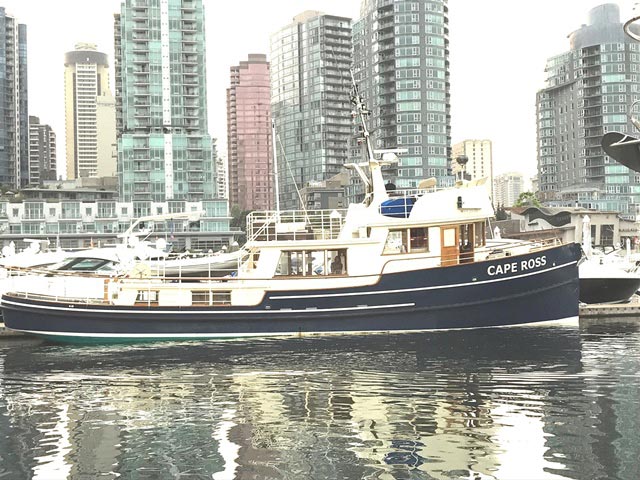 Cape RossYear Built: 1952LOA: 67'Beam: 15' 7"Owner: Darryl RawlingsDesigner: UnknownDesign: Purse Seine vesselType: Power
Cape RossYear Built: 1952LOA: 67'Beam: 15' 7"Owner: Darryl RawlingsDesigner: UnknownDesign: Purse Seine vesselType: PowerTopsides re-planked, hull totally re-calked and refastened in 2018. Hull, topsides and cabin repainted in 2018.
-
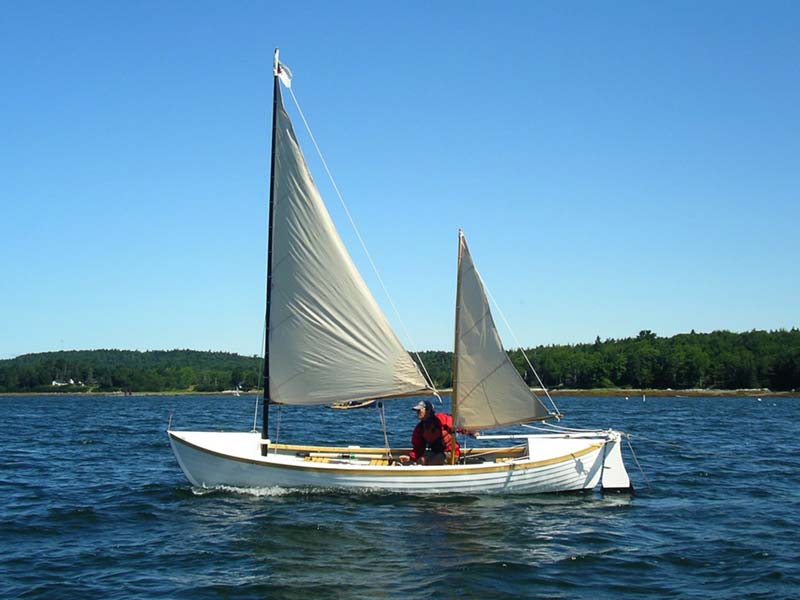 Carpenter IIYear Built: 2007LOA: 18'Owner: Denis WangDesigner: L. Francis HerreshoffDesign: CarpenterType: Ketch
Carpenter IIYear Built: 2007LOA: 18'Owner: Denis WangDesigner: L. Francis HerreshoffDesign: CarpenterType: KetchBuilt in Maine in 2007, she has plied Maine’s coastal waters and primarily Penobscot Bay, until she was brought here last June, where she resides in Port Hadlock. She was a mainstay vessel at the annual TSCA Small Reach Regatta in the Eggemoggin Reach area of Maine. With a small canvas area for her ketch rig, an 18 ft. length and a 4 ft. 6 in. beam, drafting 5 in. with her centerboard up, she is a slow but steady, sound, and balanced vessel that could best be described as a cross between a lifeboat and a dory. She is glued-lap of Meranti plywood and weighs 450 lb. empty. She is also a safe vessel with two water-tight turtlebacks fore and aft. In light winds, she sail/rows comfortably but really enjoys a stiff breeze, when other small boats are reefing and heading to harbor.
-
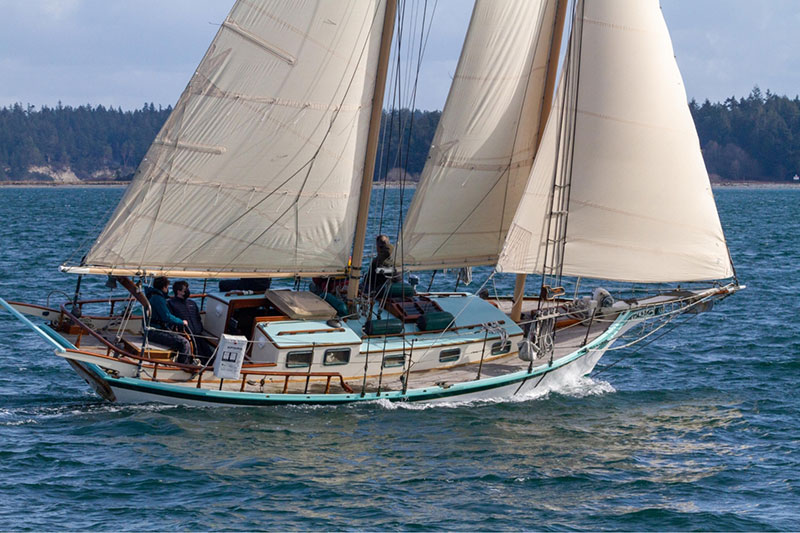 CeridwenHome Port: Port Hadlock, WAYear Built: 1993LOA: 39'Beam: 10'Owner: Matthew McClearyDesigner: William AtkinsDesign: Little Maid of KentType: Schooner
CeridwenHome Port: Port Hadlock, WAYear Built: 1993LOA: 39'Beam: 10'Owner: Matthew McClearyDesigner: William AtkinsDesign: Little Maid of KentType: SchoonerCeridwen was lofted in the Fall of 1982 at Magner & Sons Boatworks in Carlsborg, WA. Matt McCleary with the help of John and his son Kevin, started building the Atkins’ “Little Maid of Kent” Schooner. Poured 2500lbs of lead for Keel, Balua Keel Timbers, Oregon Oak floor timber’s and steam-bent oak frames, Port Orford Cedar planking, old-growth Douglas Fir cabin sides, Honduras Mahogany Taff rails, laid Teak decks over plywood sub deck, mahogany covering boards. All tankage (water and diesel), electrical system, and Diesel engine were installed. Pete Langley of PT Foundry cast most of Ceridwen’s deck and Spar hardware. Hassey-Petrich sails were built. Launched in August 1994, and then masts, bowsprit, and spars were finished and rigged.
Maiden voyage was in August 1996 from Port Angeles Marina to Port Hadlock Marina, Ceridwen’s Home Port to this day. Ceridwen’s custom interior was finished over many years from my garage shop in Hadlock. 20+ years now of adventures with family and friends in the San Juan Islands and Gulf Islands, BC.
-
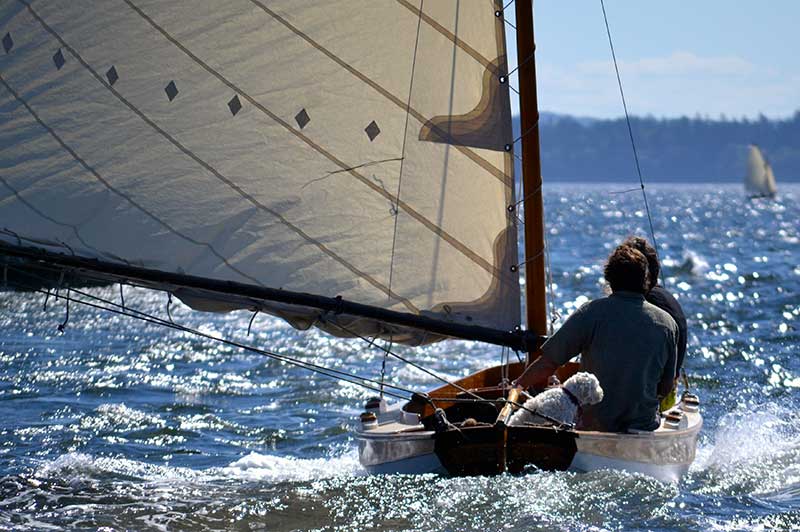 ChesukiHome Port: Renton, WAYear Built: 1986LOA: 19'Beam: 5' 8"Owner: David SmithDesigner: Charles MowerDesign: Swampscott Racing DoryType: Sloop
ChesukiHome Port: Renton, WAYear Built: 1986LOA: 19'Beam: 5' 8"Owner: David SmithDesigner: Charles MowerDesign: Swampscott Racing DoryType: SloopUsing only the lines drawing from the Dori book we measured and created a sheet of offsets to loft her. Thanks to the Newport Marine science center loft and bandsaw, I was able to fully loft her and then create her sawn frames in 1983. Thanks to Dick Tucker in Langlois Oregon I was able to order perfect Port Orford cedar for plankIng. Jamestown distributors was the only mail order supply company back then for Marine supplies (and linguica sausage)!! Coincidentally Silva Bans was being built in a nearby barn at the same time so had to have her!! The schooner Rueben de Cloux was just launched and sailed in Yaquina Bay to our delight and inspiration! Launched as an open row boat I explored the eirie Pools slough where another recluse boatbuilder was creating a wooden sailing masterpiece deep in the woods.
-
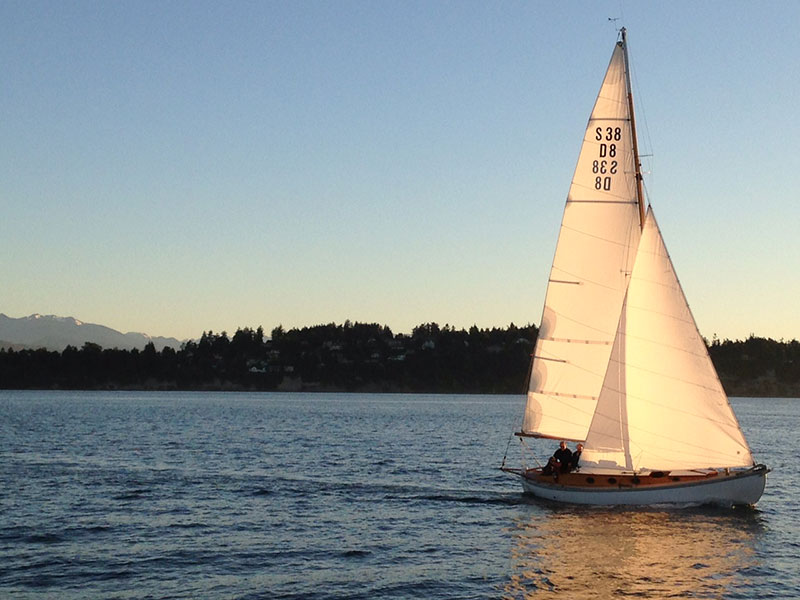 CitoHome Port: Port Townsend, WAYear Built: 1936LOA: 29'Beam: 8'6"Owner: Sean & Inger RankinsDesigner: MSJ HansonDesign: Danish 38 M2Type: Sloop
CitoHome Port: Port Townsend, WAYear Built: 1936LOA: 29'Beam: 8'6"Owner: Sean & Inger RankinsDesigner: MSJ HansonDesign: Danish 38 M2Type: SloopCito along with her sisters (Da Capo, Pia, Eio, & Skoal’s), all of the same 38M2 Danish Spidsgatter class, were shipped together from Copenhagen to Vancouver B.C. in the early 1950s. There they stayed and raced together for many years, slowly dispersing to other areas in coastal B.C. and eventually to Washington state. Skoal is still sailing in B.C. off of Brentwood Bay.
Cito was built by J. Wass, a professional boatbuilder, in his backyard in Copenhagen. Unfortunately, after WWII as things were pretty bleak in Europe, he had sold her. Cito along with her sisters and many other fine sailing craft enjoyed the many years of fun racing and cruising before the war reached Denmark and everything changed. She has spent the majority of her time enjoying racing and cruising here in the Salish Sea.
-
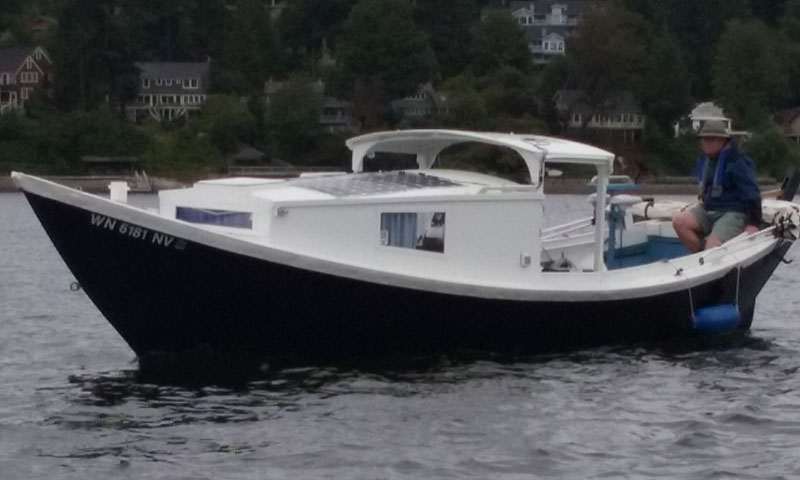 Daddy's ThirdHome Port: Olympia, WAYear Built: 2012LOA: 26'Beam: 8'Owner: Thomas HrubyDesigner: Glen-LDesign: St. Pierre DoryType: Electric
Daddy's ThirdHome Port: Olympia, WAYear Built: 2012LOA: 26'Beam: 8'Owner: Thomas HrubyDesigner: Glen-LDesign: St. Pierre DoryType: ElectricDaddy’s Third is a 26 ft St. Pierre Dory powered by two electric trolling motors. This is the third version of an electric dory I have built since 1996 and incorporates some recent innovations in electric propulsion. The two 36 volt Minn Kota motors and lithium iron phosphate batteries give us a range of 50 nautical miles at hull speed (5knots) or 150 nautical miles at 2.8 knots. 540 watts of flexible solar panels augment the power stored in the batteries at a rate of 4 hrs of sunlight = 1 hr cruising at hull speed.
-
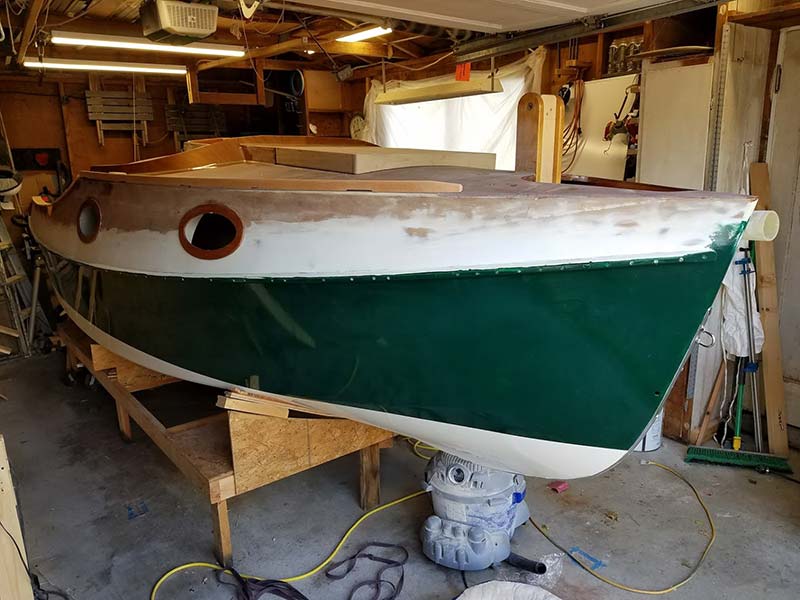 DelugeYear Built: 2018LOA: 30'Owner: Fred RowleyDesigner: Graham ByrnesDesign: Core Sound 17 mk3Type: Cat ketch
DelugeYear Built: 2018LOA: 30'Owner: Fred RowleyDesigner: Graham ByrnesDesign: Core Sound 17 mk3Type: Cat ketchThe Core Sound 17 mk3 represents the evolution of a design that has proven its seaworthiness and performance time and again in the Everglades Challenge and other race events around the country. We built Deluge because it’s readily trailerable with a small family car, reasonably quick to launch, fun to sail, and a very capable, seaworthy craft on the water. The design includes water ballast tanks which, when the seas get rough, add over 300 pounds of ballast. The cozy cabin sleeps 2 with tons of storage space for extended trips.
-
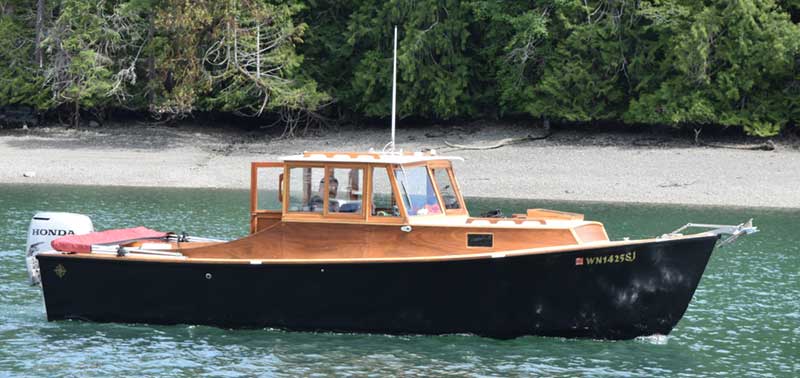 DescantFor SaleYear Built: 2007LOA: 24'Owner: Ty HeslopDesigner: UnknownDesign: Chesepeake Marine DesignType: Power
DescantFor SaleYear Built: 2007LOA: 24'Owner: Ty HeslopDesigner: UnknownDesign: Chesepeake Marine DesignType: PowerDescant is a custom built glass over ply pilot house. She has a classic look, with the benefits of modern construction techniques and a high performance outboard. Her hull offers a fast and fuel efficient ride. She can travel from Kingston to Friday Harbor in a few hours, using less than 14 gallons of fuel. Likely, she is one of the few boats that has explored the rivers of eastern Washington. She is young, elegant, and fast. Perfect for the couple who has to be to work on Monday morning.
-
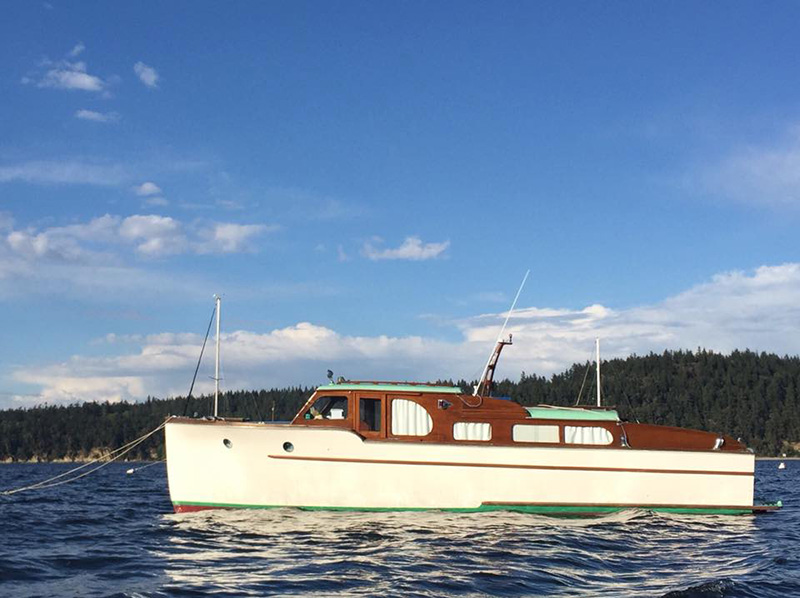 Duffy & DinkyHome Port: Tacoma, WAYear Built: 1950LOA: 35' 10"Beam: 10' 6"Owner: Evan & Sara BaillyDesigner: Edwin Monk Sr.Design: Bridgedeck CruiserType: Power
Duffy & DinkyHome Port: Tacoma, WAYear Built: 1950LOA: 35' 10"Beam: 10' 6"Owner: Evan & Sara BaillyDesigner: Edwin Monk Sr.Design: Bridgedeck CruiserType: PowerDuffy was built to a design penned by Edwin Monk Sr. in 1947 by Frank Adams under the north span of Seattle’s University Bridge. She was launched in 1950. The original owners raised their family onboard while cruising the length of the Salish Sea, making Ketchican twice. Duffy remained under their stewardship for 42 years, moored at the Seattle Yacht Club where she became something of a fixture. Her next owners treated her to a cosmetic restoration in the mid-1990s and cruised with their family for the next two decades before passing her onto us.
Our children have known her their whole lives and she was our second home in Port Townsend while I attended NWSWB. That is when she received her tender, “Dinky”, a pram designed in 1932 by Monk and built at the “boat school” in 2018/19. After 70 years, Duffy needed a structural restoration, and as she is a member of our family, we obliged. She has undergone a yearlong rebuild, refit, and restoration to ensure that she is still something to enjoy in the next generation.
-
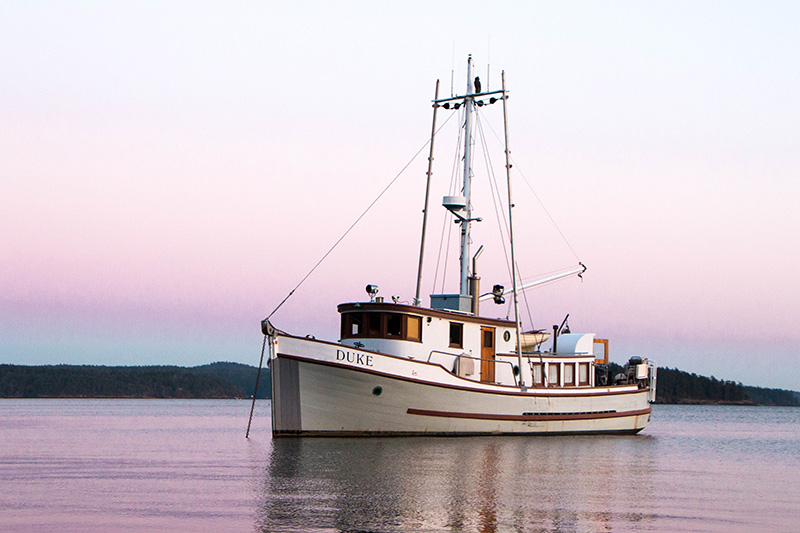 DukeHome Port: Bellingham, WAYear Built: 1947LOA: 47'6"Beam: 13' 4"Owner: Ryan DownsDesigner: UnknownDesign: TrollerType: Power
DukeHome Port: Bellingham, WAYear Built: 1947LOA: 47'6"Beam: 13' 4"Owner: Ryan DownsDesigner: UnknownDesign: TrollerType: PowerDuke was built in 1947 by the Adolph Cummings Boat Company on Ruston Way in Tacoma, Washington. Built to troll fish, she had two sister ships, Solveig, and Ample II. She trolled in Alaska until the mid-1950s when she moved to Eureka, California, working troll, crab, and longline. While there, she made a brief appearance in the film “Jennifer 8” in 1992 and made her way back to Washington soon after.
Bought by a Port Townsend couple in the mid-1990s, she was converted to a cruising vessel and visited the San Juans and British Columbia often. Bought in 2o15 by her present owner, Duke offers adventure cruises in the San Juan Islands and British Columbia.
-
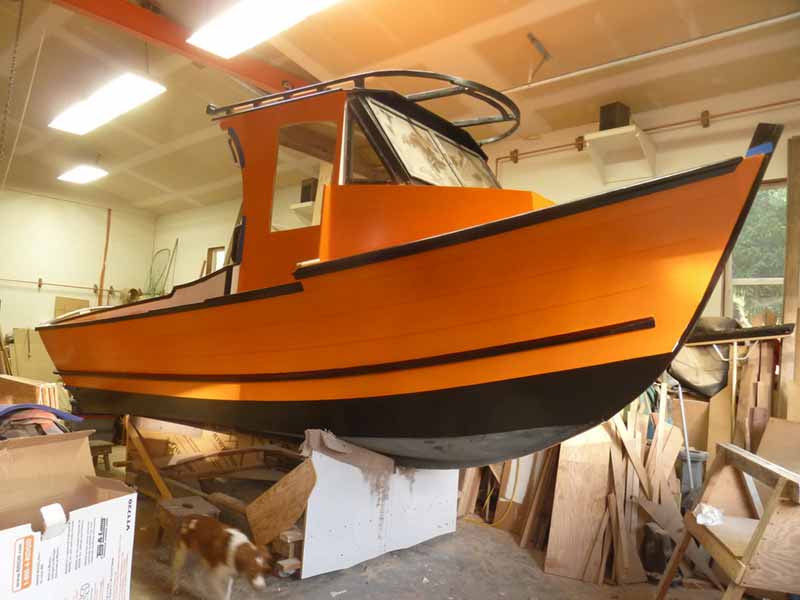 Eager BeaverHome Port: Hood River, ORYear Built: 2013 - 2018LOA: 23'Owner: Robert GodardDesigner: T.N. SimmonsDesign: Simmons Sea SkiffType: Power
Eager BeaverHome Port: Hood River, ORYear Built: 2013 - 2018LOA: 23'Owner: Robert GodardDesigner: T.N. SimmonsDesign: Simmons Sea SkiffType: PowerSimmons Sea Skiff, 22 footer. Powered by 90 hp Suzuki outboard. Built to plans, but, with my tweaking, Eager Beaver is at 23 feet. I included a cuddy cabin with horizontal 6 feet 6 inch interior, but low ceiling. Added three-sided ‘hardtop’ to protect occupants in helm area. Curved handrail on top is unique – a ‘one of a kind’, but patterned after one seen on a commercial build by Life Proof Boats (with their permission). Lapstrake hull. All wood above the chine is MDO plywood. Double thick (3/4″) bottom. Non-skid areas use crushed walnut shells. All fasteners, cleats, chocks, Samson post, are silicon bronze. Tall transom adorned aft with four foot wide ‘coastal native style carving’ of a beaver. Boat is painted bright orange/black trim, as it reflects both the ‘beaver’ name, and my university roots at Oregon State. Name EAGER BEAVER comes from my dad always encouraging me as a young boy to be an ‘eager beaver’. Build began fall 2013, and is completed by summer of 2018.
-
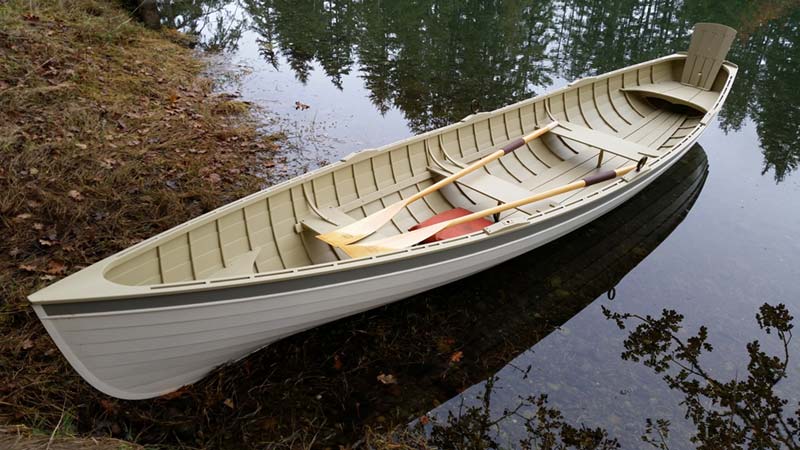 EbbHome Port: Allyn, WAYear Built: 2015LOA: 15' 9"Owner: Tom & Susanne ReganDesigner: Tom Regan - Grapeview Point Boat WorksDesign: Lake George BoatType: Row
EbbHome Port: Allyn, WAYear Built: 2015LOA: 15' 9"Owner: Tom & Susanne ReganDesigner: Tom Regan - Grapeview Point Boat WorksDesign: Lake George BoatType: RowEvery now and again, we build a boat for ourselves. We wanted a good rowboat, which meant it had to meet several criteria:
• It had to row very well.
• It had to be lightweight for its type.
• It had to have a traditional appearance.
• It had to be a relatively quick build so I could get back to projects that made money.
• It had to be fairly inexpensive.
• It had to trim well rowing single or double, with or without passengers.We have long admired the Lake George Boats, and decided to base our design on the WINONA from Mystic Seaport’s collection of small boats. The Gig Harbor BoatShop built a replica of WINONA a couple years ago, and I had a chance to row it briefly. I found that the hull had more than adequate stability, and carried between strokes very well. She was slow to turn, like any long pulling boat with no rocker. We began by making a 1:8 scale half-hull model of WINONA, then modified the model to reflect the new design, which was named EBB. We trimmed the beam to get the beam to length ratio to be less than 1:4. This reduced the stability, while also slightly reducing the weight and wetted surface for less drag. We kept the nearly circular midship cross-section. The beam at the transom was greatly reduced to be less than 45% of the maximum beam. This, combined with the low beam/length ratio, categorizes our design as a “”canoe, kayak, or similar watercraft”” in the eyes of the USCG, simplifying certification of the new design.
The stem profile was straightened a bit to suit our taste. That lengthened the waterlines slightly. The dead-straight keel was modified to have 1″” of rocker at both ends. This will help maneuvering in tight spaces, and make exiting onto a beach a little easier. With the revised model completed, templates and measurements from the model were used to create a scale lines drawing, from which offsets could be taken in order to loft the boat full-size. Construction details were drawn on the lofting, and the molds and stem and transom patterns were made.
All the scantlings were reduced, and much lighter species of wood were used. Where the original boat had oak, we substituted yellow cedar. Fir was replaced with spruce. Pine was replaced with red cedar. Quarter inch cedar planking became 4mm Okoume plywood. The resulting build will not be as durable as a boat built more heavily, but this boat will be used by us, and will be handled carefully. EBB will be a test bed for new ideas in construction and interior arrangement. The thwart arrangement is a bit of an experiment (something I can’t do with boats built for others). The center thwart is located just aft of amidships, which is optimal for trim. The forward thwart is farther forward than usual, and the aft thwart is farther aft than usual. This should maintain trim with two rowers, without the need for adding ballast. No heel stretchers are required, since feet can be braced against the thwarts and stern seat.
Having three thwarts does crowd the interior, especially at the bow seat, but there a plenty of options for seating, and the bow seat is really only intended to be used a step when boarding from a beach, or perhaps used as a seat by a child (or a dog).There is no varnish. We used a satin enamel for the interior, and gloss enamel for the exterior. A simple finish, stored out of the weather, should require very little maintenance.”
-
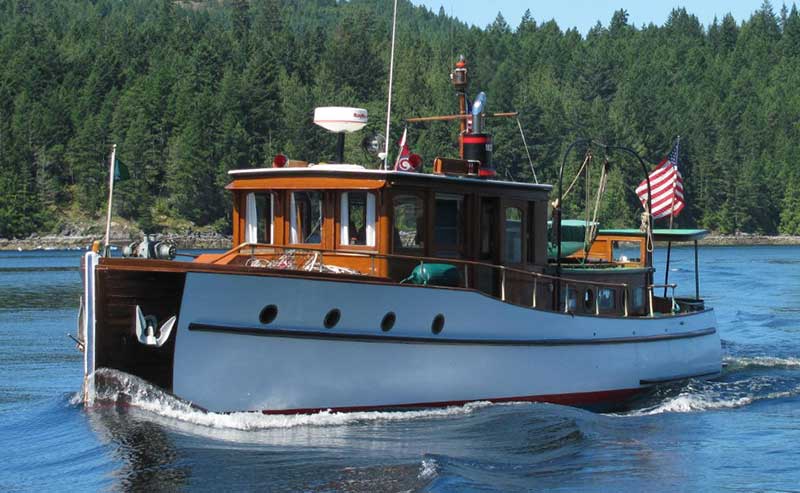 El MisticoHome Port: Oakland Bay Marina, Shelton, WAYear Built: 1927LOA: 44'7"Beam: 10'6"Owner: James PoirsonDesigner: Theorel and NordstromDesign: Bridge Deck CruiserType: Power
El MisticoHome Port: Oakland Bay Marina, Shelton, WAYear Built: 1927LOA: 44'7"Beam: 10'6"Owner: James PoirsonDesigner: Theorel and NordstromDesign: Bridge Deck CruiserType: PowerA number of such installations have been made on the West Coast and are being watched with keen interest by motor boat operators everywhere.
A particularly striking yacht installation was that made in the 44-foot power cruiser El Mistico owned by E. Michelson of the Seattle Yacht Club. The El Mistico was built by the Ballard Marine Railway of Seattle from designs by Thearle and Nordstrom and embodies a number of striking features in design, construction, and arrangement.
The power plant is one of the new four-cylinder Fairbanks-Morse marine Diesel engines developing 40 h.p. at 650 r.p.m. This engine is of the two-cycle type. The installation was made under the personal supervision of A. F. Whitehead, manager of the service department of the Seattle branch of Fairbanks-Morse & Company.
A feature of the job is the special unit control stand designed by Fairbanks-Morse engineers, and due to the success of the El Mistico will be made standard on this type of craft. By the use of this control, which is in a single bronze casting, the engine can be started, the clutch manipulated, the speed regulated and the reverse operated by the man at the wheel. Air and oil pressures are carried to the pilot house so that the owner can at all times follow the operating conditions of the engine. There is a thermostatic monometer for indicating engine temperature.
…The centralization of controls enables one man to operate the boat readily.